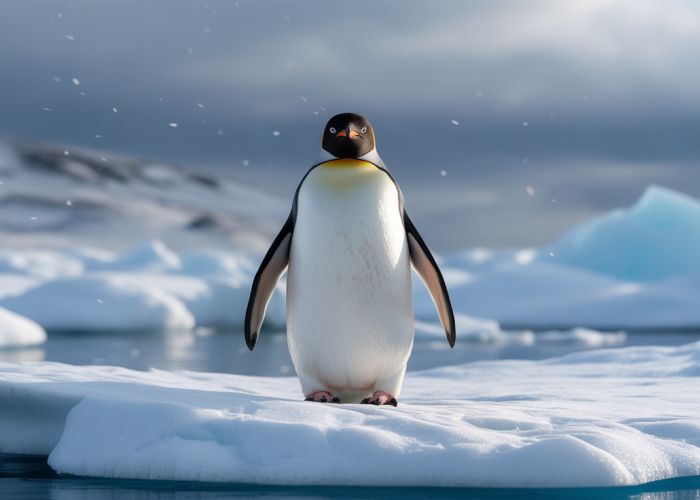The Arctic ecosystem, a fragile environment, presents unique challenges for its inhabitants. Climate change significantly impacts the habitats where many species live, altering their survival strategies. Ocean currents influence the distribution of food sources critical for species like the penguin in arctic to thrive. Therefore, the International Arctic Research Center studies these complex interactions to better understand and preserve the future of Arctic wildlife.

Arctic Penguins: Structuring an Informative Article
Given the topic "Arctic Penguins: Amazing Survival Secrets Revealed!" and the focus keyword "penguin in arctic," crafting a compelling and informative article requires a specific layout. However, it’s crucial to understand that penguins do not live in the Arctic. They are found in the Southern Hemisphere, primarily in Antarctica and surrounding regions. Therefore, the article must address and correct this misconception early on, while still delivering engaging content about penguin survival strategies.
Here’s a suggested structure:
Addressing the Misconception: No Penguins in the Arctic
The article must begin by directly addressing the common misconception. Failing to do so will mislead readers and damage credibility.
- Introduction: Start with a captivating hook that acknowledges the common belief about "penguins in the arctic." Then, immediately clarify: Penguins do not live in the Arctic.
- Example: "The image of a penguin waddling across Arctic ice is a popular one. But while these flightless birds are masters of cold-weather survival, you won’t find them near the North Pole. Penguins are exclusively Southern Hemisphere inhabitants."
Understanding Penguin Habitats: The Southern Realm
This section transitions from correcting the error to providing accurate information about where penguins actually live.
- Global Distribution: Discuss the general distribution of penguin species. Highlight Antarctica, sub-Antarctic islands, and the coasts of South America, Africa, and Australia.
- Use a map image to visually illustrate penguin distribution.
- Key Habitats: Describe the different environments penguins inhabit:
- Icy landscapes of Antarctica
- Rocky coastlines of South America
- Warmer climates like those found in the Galapagos Islands (showing habitat variety)
Antarctic Survival: The Real Story
Now that the location is established, focus on how penguins thrive in challenging cold environments, specifically Antarctica. This fulfills the original promise of "survival secrets."
Adapting to the Cold: Physical Characteristics
- Feathers: Explain the importance of dense, waterproof feathers for insulation. Discuss how penguins preen and oil their feathers.
- Blubber: Detail the role of blubber as a layer of insulation and energy reserve.
- Circulatory System: Explain how penguins’ circulatory systems reduce heat loss in their extremities (countercurrent heat exchange).
- Consider using a simple diagram to illustrate countercurrent heat exchange.
Behavioural Adaptations: Thriving in Numbers
- Huddling: Describe the huddling behaviour penguins use to conserve heat. Explain how penguins rotate positions within the huddle.
- Migration: Detail migration patterns of some penguin species in search of food or breeding grounds.
- Foraging Strategies: Explain how penguins hunt for fish, krill, and squid in icy waters.
Specific Penguin Species and Their Adaptations: Case Studies
This section provides concrete examples of penguin species and how their specific adaptations allow them to thrive.
- Emperor Penguins: Detail their unique breeding cycle during the harsh Antarctic winter.
- Adelie Penguins: Describe their resilience and adaptation to icy landscapes.
- King Penguins: Explain their extended breeding cycle and adaptation to sub-Antarctic islands.
Use a table to compare key adaptations across different penguin species:
| Penguin Species | Key Adaptation | Benefit |
|---|---|---|
| Emperor | Winter Breeding | Avoids summer ice melt impacting chicks |
| Adelie | Rapid Nesting | Takes advantage of short ice-free periods |
| King | Long Breeding Cycle | More parental care for chicks |
| Galapagos | Tolerance to warmer climate | Allows habitation near the equator |
Addressing Related Misconceptions and Interesting Facts
This section can address other penguin-related misconceptions or provide intriguing facts to maintain reader engagement.
- Penguin Predators: Discuss natural predators of penguins, such as seals, orcas, and seabirds.
- Conservation Status: Briefly touch on the conservation status of various penguin species and the threats they face (climate change, pollution, overfishing).
- Evolutionary History: Briefly describe the evolutionary history of penguins.
FAQs: Arctic Penguins – Unveiling Their Survival Secrets
Here are some frequently asked questions about arctic penguins and how they manage to thrive in such a challenging environment.
Are there really penguins in the Arctic?
No, penguins are not naturally found in the Arctic. Penguins are primarily found in the Southern Hemisphere, particularly in Antarctica and surrounding regions. The misconception likely arises from confusing penguins with other cold-climate birds.
What kinds of animals do arctic penguins eat?
Since penguins don’t live in the Arctic, they don’t consume any Arctic animals. However, penguins in Antarctica and other regions of the Southern Hemisphere feed primarily on krill, small fish, and squid, depending on the species and availability.
How do penguins stay warm in cold regions?
Penguins have several adaptations to stay warm. They have a thick layer of blubber for insulation, densely packed feathers that trap air, and a countercurrent heat exchange system in their flippers and feet, which minimizes heat loss. Some penguin species in arctic-like condition also huddle together for warmth.
Where can I see penguins in their natural habitat?
You can see penguins in various locations throughout the Southern Hemisphere. Antarctica is a popular destination for viewing emperor penguins and other species. You can also see penguins in South Africa, South America (like in the Galapagos), and New Zealand. Although no penguin in arctic region, visiting these places can offer you a truly incredible wildlife experience.
So, next time you think about the resilient penguin in arctic, remember the incredible adaptations they’ve developed. Hopefully, you’ve learned a thing or two about their amazing survival strategies!